- HOME
- BEST POKER TRAINING SITES
- POKER GUIDES
- ONLINE POKER ROOMS GUIDE
- POKER NOTES LIVE APP
- MORE
Finding yourself at a table with one or more players who seem keen on taking almost every hand to a showdown can be a tricky, but profitable, situation.
Sometimes it looks like these guys only know poker rules and make random plays, but to counter them efficiently you need to quickly recognize these players at the table and make some adjustments to your regular playing style.
Once you do, you can use these three tips to crush passive players and take their chips.
The first thing you need to come to terms with is that these players pretty much can’t be bluffed. Occasionally, a situation may arise where firing a bluff may be the appropriate strategy but, in general, you want to seriously reduce your bluffing frequency against these players.
The fact they’ll happily call off two or even three barrels with hands as weak as fourth pair (or worse!) means that your bluffs simply lose value. These opponents simply won’t give up often enough to make bluffing in most “standard” spots profitable.
Additionally, when solid bluffing spots do appear, you should usually make your bet size smaller against calling stations. These players are usually in “call or fold” mode, so your bluffs will be just as successful whether you fire a half-pot or 1.5x pot bet. When your bluff doesn’t go through, though, you won’t be losing as much.
The fact that players we categorize as calling stations go to showdown with very weak hands opens them to a world of problems when they find themselves against a competent player. If your Hold’em Manager or other tracking software indicates that your opponent is a passive calling station, you need to adjust your value range to include some hands that you usually wouldn’t bet for value.
This covers a relatively wide spectrum of situations that you’ll simply need to recognize while playing. For example, in the spots where your pocket pair is lower than the highest card on the board but you know the player will call you down with much weaker than the top pair, you need to sometimes go for full value.
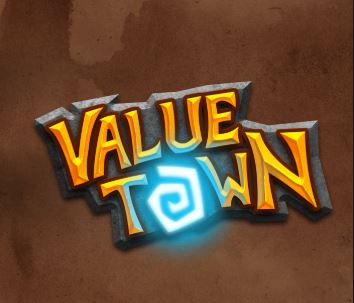
Usually, if these players have a hand as strong as a top pair, you’ll find out about it at some point during the hand. If they’re content to just check-call all the way, they’re far more likely to have something like second or even third pair. While this isn’t a strategy you’d generally adhere to against an average, solid opponent, it is a valuable adjustment to be making against calling stations.
Another adjustment you should make when playing against passive calling stations has to do with your bet sizing in value spots. In general, we tend to size our value bets in a way that we believe will produce the desired outcome (the call from our opponent). Against players who tend to be very sticky and have problems folding their weak hands though, we can get away with making big value bets with impunity.
On average, players who belong to this category think along the lines “call or fold” (as already mentioned) and the size of your bets doesn’t really affect their decision that much. So, for the same reason you should make your bluffs smaller, you should make your value bets bigger. Over-betting the pot in situations where your opponents clearly have something they want to take to the showdown is a great way to maximize your profits.
Once again, you don’t really have to worry about balancing your bet sizes against these players. Even if you had them crushed twice already when you made a huge river bet, they’d still keep calling you down with weak hands, believing that their hand must be good at least sometimes. You’ll be able to make a lot of money off of them before they start to adjust, if they ever do – and that’s a big if.
Just a little over a year ago, my girlfriend and I were texting each other about dream jobs.
Her dream, once upon a time, was to work in sports media, which she did for a while before finding her current and very fulfilling career path.
I didn’t have to think too hard about what my dream job would be; traveling around the world and crushing high roller poker tournaments for millions of dollars. Aside from that though, there’s no doubt; writing about poker is my dream job.

A tournament I won in a Las Vegas casino back in December 2013
I dabbled in poker writing a little bit as a tournament reporter at the World Series of Poker in 2009 and 2010, and I was conversing with my girlfriend about that gig. We both came to the conclusion that it was time for me to start looking for freelance work in the poker media realm.
If you’ve ever tried to break into a particular niche of freelance writing, you know how much work goes into finding potential outlets to work for.
I started visiting every poker news site I think of, combing their websites to find out if any of them were looking for contributors. One of the first sites I came across was the Cardplayer Lifestyle Poker Blog, and much to my excitement I found this:
I emailed Robbie and pitched a couple of stories, introducing myself as someone who was pursuing their dream career in poker media. Much to my surprise and delight, Robbie responded within 24 hours and approved one of the pitches!
He informed me that if that article went well, it could potentially turn into a monthly gig for me. I had just started playing poker again around that time, after taking three-year break, so my first poker article in eight years was a story about the thrill of playing again after taking time off.
The thrill of having an article published was even greater. I started spending a lot of time watching the WSOP from past years, the WPT, YouTube videos, and anything else I could find related to poker.
I wanted to always have several story ideas ready for my monthly Cardplayer Lifestyle article, which I feel blessed to still be doing 13 months later! I also just wanted to soak in as much knowledge about the modern poker landscape as I could, while looking to go further in this poker writing pursuit.
I was also spending as much time as possible playing poker at that point. I was a Sit & Go specialist back in the day, but this time around I wanted to learn how to play cash games, something I had very little experience with.
If you’ve ever tried to transition to cash games from a tournament background, you know these are two different worlds. Dipping my toes back in the water, I signed up at Replay Poker as well as a couple other sites. After a nice start at the online microstakes, I started losing, decisively, and knew it was time to step up my study game away from the table.
Somewhere along the way, I came across this motivational speech from Doug Polk:
I had never been more fired up to improve my game, and it was time to put some real work into getting better. So at that point, around the beginning of summer 2018, I was spending nearly all of my free time trying to get better at poker, and trying to get better at poker writing.
As it so happens, Doug Polk is one of the co-founders of Upswing Poker, a poker training site with an extensive library of learning materials. I signed up for the Upswing Poker Lab and started really trying to understand what it takes to be a winning player.
I was still looking for writing opportunities at the time as well, Googling things like “poker writing jobs”, sending cold emails to poker media outlets, and combing freelance job boards like Upwork every day, just to make sure I didn’t miss out on any potential opportunities.
During this search, I came across this Reddit thread from 2017:
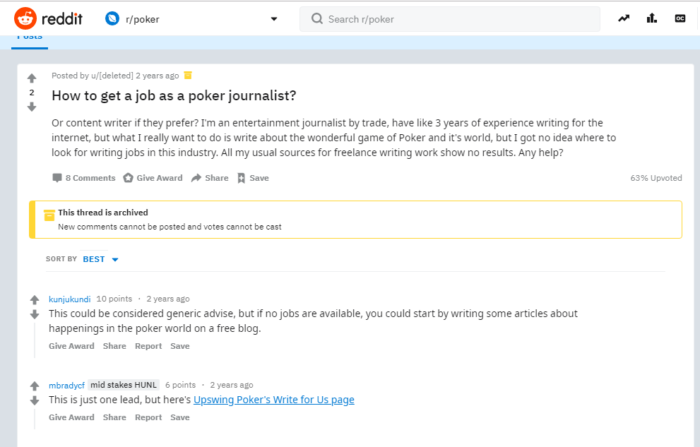
I had spent a good amount of time on Upswing, and that lead at the bottom of this screenshot was a potentially exciting opportunity. I sent in an application, and a few weeks later starting contributing.
So at this point I’m writing at least 3-4 articles a month total, for Cardplayer Lifestyle and Upswing Poker. I’m well aware of just about every other poker media outlet in existence, as I’ve contacted them all at this point.
I’m working out at the gym one day in early 2019, and in between sets I’m scanning Twitter.
Lance Bradley from PocketFives had tweeted that he was looking for U.S.-based poker writers and to DM him if interested. I finished up a set of shoulder presses and immediately went home, cutting the workout short. I needed to apply for that spot ASAP.
I came home and contacted Lance, and found out that he was looking for a writer to cover U.S. online poker legislation. As an avid online player, this topic is of great interest to me, and for the past few months I’ve had the opportunity to contribute to PocketFives, covering some of the developments as they happen in Pennsylvania and West Virginia, the two most recent U.S. states to legalize online poker.
So, at the one-year point of this journey, I’m now contributing to three great poker websites and spending much of my free time writing about poker. Between the poker writing duties and my other gig, which is working in the craft beer industry here in San Diego, life is good!
Getting up in the morning and having the opportunity to work in a field that you love is priceless.
We’re one month away from the start of the 50th Annual WSOP! What event are you most looking forward to?
2019 WSOP Schedule: https://t.co/I3HoFxANCy pic.twitter.com/tQAnKLONDl
— WSOP (@WSOP) April 28, 2019
Over the past year, I’ve been aware of a Live Reporting Blogger position that’s listed on PokerNews. I wanted to apply for it, but before I did I emailed Robbie.
Robbie is a self-made man in the poker media industry, and I wanted to get some insight from him about how I could really make myself stand out when applying for this position with PokerNews. He immediately emails me back and says “let’s talk about this over the phone.”
It’s 1 p.m. here in California, which means it’s 11 p.m. in Israel, where Robbie resides. Despite the late hour, and the fact that he’s feeling under the weather, Robbie is willing to talk about this right now!
After answering some questions I had, Robbie offered to make an introduction to Yori Epskamp, the Head of Live Reporting for PokerNews. A door had opened. Now it was up to me.
I’ve reflected on those summers working at the 2009 and 2010 WSOP many, many times. My life took a different path in the 2010s and I never thought I would be back at the WSOP.
But this year it’s happening. After corresponding with Yori, I received an offer to work as a live reporter at the 2019 WSOP, for PokerNews. I’ll be in Las Vegas for the duration of the 50th Annual World Series of Poker, which is now just a couple of weeks away.
Working toward a big dream comes in little steps, little pieces. If there’s something you want to do in life, think about what the very first step would be in moving toward that dream. And keep stepping, keep striding, keep running with it!
Editor’s note: This is Lesson #13 in our weekly “Strategy with Stas” series. Stas Tishkevich, founder of the Poker Fighter Training App, brings you a new lesson in article + video format. We hope you enjoy this feature from the Poker Fighter School, and would be happy for you to share these posts — as well as your feedback — on social media.
Action is folded to us and we see ace-jack offsuit in the dealer position. We will open-raise from this position at least 42% of possible starting hands, and ace-jack offsuit is at the top of our opening range, so we should always open-raise this hand in this spot.
If a player in one of the blinds were to re-raise, we would probably call vs. most player types except vs. those who use a very-tight 3-bet range (QQ+, AK for example).
Happily for us, only the small blind calls, and now our mission is to think about his possible range of hands, meaning which hands will he play like this.
If we think the opponent is a loose-passive player type, as the majority of players at low stakes are, we can assume he plays like this mostly pocket-pairs (22-TT), suited aces (A2s-AJs), broadway cards (JT-AT, QJ-AJ, KQ), and maybe suited connectors (32s-T9s). Looser players can also call with low suited kings (K2s-K9s), suited one-gappers (42s-T8s), and offsuit hands like T9o, Q9o, J9o, etc.
We should assume his range is capped, and that he won’t have hands like jacks or better or ace-king, as most players would re-raise (3-bet) with these hands vs. a player in the dealer position’s open-raise.
We are ahead of this range with our ace-jack offsuit, and feeling pretty good about this spot given our initiative and positional advantage.
The flop comes Ac5c3d, which is a wet flop, as it offers many flush and straight draws. We don’t have a chance to think whether we should check or bet this flop, as our opponent decides to lead with a small donk-bet!
Donk bet means that the opponent who was passive pre-flop and whose range is probably capped, takes the initiative on the flop and leads with a bet, instead of checking to the original pre-flop raiser. A small donk-bet is usually a losing move made by amateur poker players for one of two reasons:
Either way, usually they will not have a strong made or drawing hand, and we can put pressure on their bet by calling or raising in position a wide range of hands.
We’ve hit top pair with a decent kicker and now need to decide between calling and raising.
If we call it will be for pot control, meaning we think our hand is mediocre and are not sure we have value to collect by raising.
If we raise it’s for value and to protect our hand vs. potentially bad turn cards (a 2 or 4, for example).
In this case it seems like we have tons of value to be gained from any ace with weaker kicker, any pair, a gutshot, and flush or straight draw, etc.
We choose to raise 5x his bet as it is a draw-heavy flop, and the opponent folds.
The main point we need to understand here on the flop, is that when facing a small donk bet on a wet flop, we should assume that the opponent’s range is medium-weak, and that any decent hand we have should probably be raising for value and protection.
Just calling versus small donk bets on wet flops is usually not a good idea.
A path to becoming a better poker tournament player is a never-ending one. There are always bits and pieces that you can learn, strategic adjustments you can apply to your game, and new ideas you can try. So, it is impossible to sit down and learn everything there is to know about tournament poker – you have to learn about all these various aspects one at a time and add them to your game-plan. And that’s exactly the idea behind the Red Chip Poker MTT 3-Bet Shoves Crash Course.
Instead of being all over the place and giving you a bit of this and a bit of that, the course focuses on one very particular and very important segment of tournament play and breaks it down in detail, answering many questions about how to build your original shoving ranges, how to adjust them to your opponents’ tendencies and various tournament situations, and much more.
Although the course provides a wealth of information, it does so in a very condensed, time-saving format, with six videos lasting about 40-50 minutes each (apart from the last one), broken down by positions:
The main instructor, Ben Hayles, who created all but the final video, takes this positional approach instead of a situational one and then goes through different tournament situations for each position. As a student of the game, this approach definitely felt like an easier one to follow and it makes everything presented in the course more structured.
Throughout the MTT 3-Bet Shoves Crash Course, Hayles uses a program called HoldemResources Calculator (HRC), which is a really nice piece of software that lets you construct your ranges based on the opponents’ perceived ranges, which you can further adjust to be more in line with games you play in.
The first video lays out the structure of the course and main ideas that will be highlighted in every video, such as stack sizes, fold equity, EV calculations by chip EV (cEV) and when factoring in the ICM ($EV), opponents’ ranges and tendencies, etc. in this first part of the course, we’re introduced to all of these concepts and provided with explanations how each one of them comes into play when constructing our 3-bet shoving ranges.
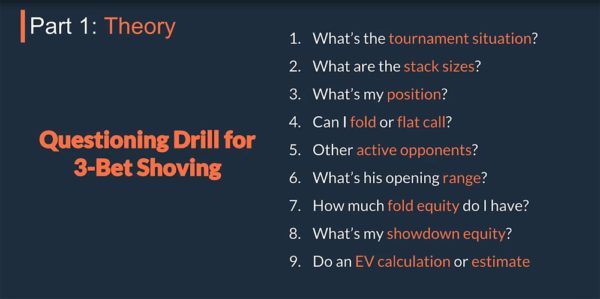
The final part of this introductory video contains a Questioning Drill, which raises several questions that will be used in all of the later videos when figuring out what to do in particular situations and how to decide what hands should and shouldn’t be included in your 3-betting ranges in different spots.
First two videos in the course address the play from the blinds. In the first video, Hayles constructs ranges for the big blind and explains some interesting and relevant ideas about the big blind. While it is usually considered one of the two worst positions to be in, 3-bet shoving helps you get rid of the positional disadvantage. At the same time, being last to act before the flop, you get to have most information before you make your move. He also mentions the ever-important concept of pot odds, which is especially important in the big blind, when you already have money in the pot.
The second video discusses small blind and although many of the ideas are similar, we always have to factor in for the big blind still to act behind us, as they could potentially wake up with a hand. One important takeaway from both of these videos, though, is that we should have pretty wide 3-bet shoving ranges in the blinds but always keep in mind things such as fold equity (or non-existence thereof), ICM, and our opponents’ calling ranges.
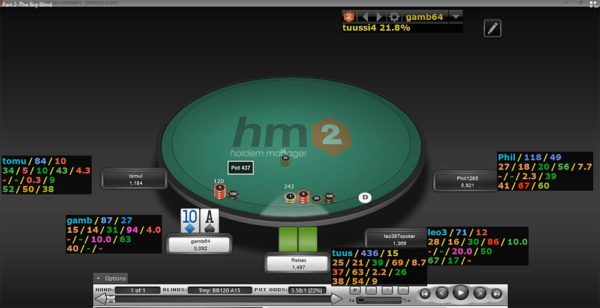
The video on the cutoff and button play is structured in the same way, going through all the same motions where we consider the position of the original raiser, our stack depth, and ICM. However, at this point, Hayles also introduces the idea of constructing calling ranges, which aren’t as big of a consideration when playing from the blinds. He emphasizes the importance of building both of these ranges together and including more hands into your calling range as stacks get deeper, especially on the button where we are guaranteed to have position after the flop.
Finally, we look into constructing 3-bet shoving ranges from early and middle positions. This is where our ranges become much more rigid as we have so many players to act behind that we can’t afford to play too wide. With deeper stacks, especially, there will be far more hands included in our calling range.
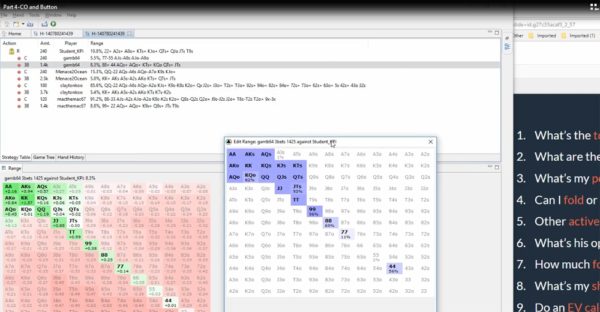
Constructing ranges
In all of the videos, there are several hand examples explaining concepts that have been discussed at various stages of a tournament:
The final video in the MTT 3-Bet Shoves Crash Course was produced by Gareth James, and although it is shorter than other lessons (only about 25 minutes), it helps wrap things up nicely by looking at 3-bet shoving ranges at different stages of a tournament:
The video uses the same approach, applying HRC calculations to come up with optimal ranges for different scenarios. This one is an excellent resource to understand just how big of an impact ICM has in tournaments, especially in satellites with a short stack and several similarly-sized stacks.
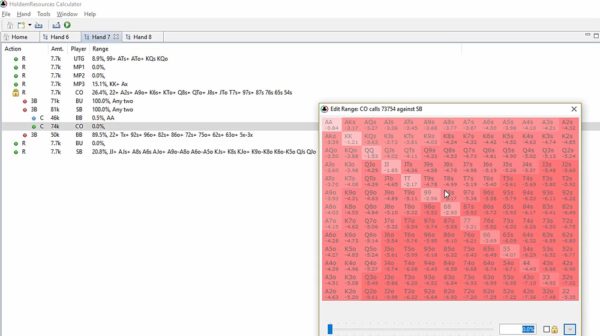
In a satellite with a short stack and several similarly sized stacks, the original opener should fold 100% of their range to your shove, including pocket Aces
Of course, the video also addresses the issue of your opponents’ playing without taking ICM into consideration and just using the standard cEV calculations. In this kind of a scenario, we must change our 3-betting ranges quite significantly and tighten up as we can’t afford to get looked up lightly with significant money jumps imminent and shorter stacks waiting to bust.
Paying for resources is often a painful point with poker players because there genuinely is so much useful poker information online for free. While this is true, you won’t find this type of information organized in such an easy-to-follow way and presented with in-depth explanations and great examples.
As such, at just $69.99, Red Chip Poker’s MTT 3-Bet Shoves Crash Course is really a steal. It will help you greatly with constructing your shoving ranges at various stack depths and at different stages of a tournament that it will surely end up paying for itself many times over. The additional cherry on top is that you can actually download the course to your computer (around 500MB in total) so it can be yours forever.
If you’re looking to improve your MTT game and figure out how to be more aggressive in the spots that make sense, you’ll definitely want to buy this course. It will help your ROI increase by quite a margin in no time! Red Chip Poker content is always great, and this course is no exception!
Editor’s note: This is Lesson #12 in our weekly “Strategy with Stas” series. Stas Tishkevich, founder of the Poker Fighter Training App, brings you a new lesson in article + video format. We hope you enjoy this feature from the Poker Fighter School, and would be happy for you to share these posts — as well as your feedback — on social media.
Action is folded to us and we see ace-four suited in the dealer position. We will open-raise from this position at least 42% of possible starting hands, and ace-four suited is at the top of our opening range, so we should always open-raise this hand in this spot.
If one of the blinds were to re-raise, we would probably call versus most player types except against those who use a very tight 3-bet range (QQ+, AK for example).
Happily for us, only the small blind calls, and now our mission is to think about his possible range of hands, meaning “what hands will he play like this?”
If we think the opponent is a loose-passive player type, as the majority of players at low stakes are, we can assume he is playing mostly pocket-pairs (22-TT), suited aces (A2s-AJs), broadway cards (JT-AT, QJ-AJ, KQ), and maybe suited connectors (32s-T9s). Looser players can also call with low suited kings (K2s-K9s), suited one-gappers (42s-T8s), and offsuit hands like T9o, Q9o, J9o, etc.
We should assume his range is capped from having hands like Jacks and above or ace-king, as most players would re-raise (3-bet) with these hands versus a dealer’s open-raise.
We are ahead of this range with our ace-four suited, and feeling pretty good about this spot given our initiative and positional advantage.
The flop comes QcTd8c and we’ve got the nut flush draw! The small blind checks to us and we need to decide between betting our hand or checking behind. If we want to bet we need to find a good reason, in this case betting as a semi-bluff.
Betting as a semi-bluff means we think that stronger hands will fold to our bet. We want to fold hands like pocket pairs below eights (22-77), or bottom pair (A8 for example). If the opponent will not fold, we still will have many helpful turn and river cards that will improve our hand into a winning hand (any club and maybe an ace).
We choose to bet 3/4 of the pot as it is a draw-heavy flop, and face a raise from the small-blind. Now it’s a whole different story.
Folding is not an option as we have a lot of potential to improve and we are drawing to the nuts. We need to choose between calling for direct and implied pot odds, or re-raising as a semi-bluff.
Calling for direct pot odds means that the amount we need to call compared to the pot is less than our chances of improving to a winning hand.
Calling for implied pot odds means that when we hit our outs, we can win more chips from the opponent.
It’s again one of those times where we should really think about our opponent’s range.
Normally when playing low-stakes poker, most of our opponents are on the passive side, meaning they rarely bluff-raise, and most of the time tend to just call with their draws. These opponents will check-raise this flop with two-pair (QT for example), sets (88 for example), or straights (J9s for example).
Versus this strong range we should just call because we get sufficient direct & implied pot odds.
If we play versus aggressive player types who can bluff-raise this flop with weaker flush draws (65cc for example), a pair and gutshot (JT for example), or even made hands such as King-Queen, then we seriously think about re-raising as a semi-bluff, and then probably going all-in as we will be pot committed most of the time.
We choose to re-raise, and make it 3x the opponent’s raise, bringing him to a leverage point, meaning that he now needs to make a decision for his entire stack.
Unfortunately the small blind chooses to go all-in, and we now need to call ~$120 into a pot that will be $400 if we call, thus giving us ~30% pot odds. Even versus very strong made hands such as two-pair, a set, or straight, we still have a ~32% chance to improve into a made flush (9 outs for the turn & river), so calling here would be a +EV move.
We choose to call the all-in and from there it’s all up to “the poker gods.”
The main point we need to understand here on the flop is that when facing a check-raise, the most important thing to take into consideration is the opponent’s range, especially if he’s capable of bluff-raising or not.
Another important thing we need to remember is that strong draws play best on the flop where they have a lot of equity, so the best street to apply pressure with them is on the flop.
Our Claude Pepper Seniors Poker Group in Los Angeles has been active for over 20 years. Every Friday afternoon, a group of elderly men and women come together to play poker at the Claude Pepper Senor Center in Los Angeles. Limit hold’em is the favorite; recently they added a new casino caliber table for Omaha.
On April 5, Larry Flynt’s Lucky Lady Casino in Gardena, California, hosted members and guests (aged 50+) to a unique limit hold’em tournament. Organizing and planning the event were Shirley Tye (co-Director of the Friday games) and Ron Ross (a great ragtime pianist). I also participated. Key members of the Lucky Lady’s management team present were Eugene Shinozaki and Aaron Dennis. It was Alan Ly, manager of Larry Flynt’s other casino, the Hustler, who started the ball rolling when he approached me while I was playing there a few months earlier.
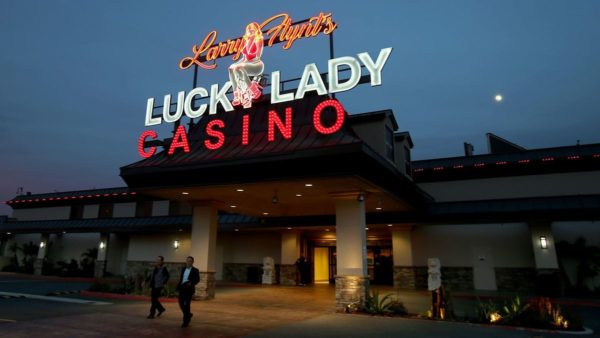
Image courtesy: LA Times
Registrants were treated to an elegant buffet luncheon before the tournament. Five tables were spread and the game got underway at 12:30 pm. It was a low buy-in limit hold’em game, ending at 5:30 pm. The winners were selected based on chip count. Top winner was my poker buddy, Byron Ziman (he has contributed to some of my poker columns in the past). Second was Richard B., one of the earliest members of the seniors poker group. I took 3rd place. In all, six cash prizes were awarded based on chip count. In addition, each of the top 10 players received non-cash prizes from the casino.
As a special bonus, players knocked out early were given the opportunity to play in a low-limit hold’em game with reduced casino rake. Everyone had a great time. Many stayed on after the tournament.
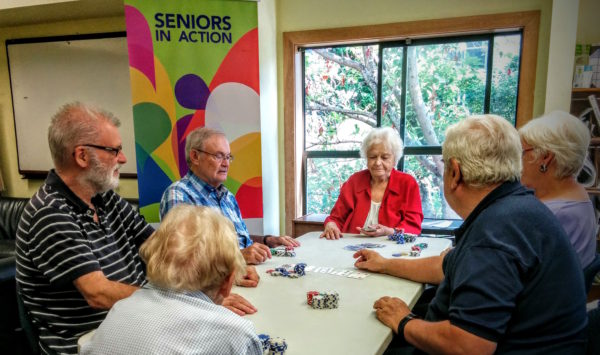
Image used for illustrative purposes only.
In 1991, after retiring from The Aerospace Corp. at age 65, I wanted to remain active. So, I continued serving on the Board of Directors of the (now global) Society for the Advancement of Material and Process Engineering. For recreation, playing poker would be my venue. I loved it – the excitement, the mental challenge, and social interaction.
Shortly after, I was invited by the Claude Pepper Senior Center to give a short talk about poker for seniors. Afterwards, the center director came over, shook my hand, and praised my talk. Then he dropped a “bomb” on me: “How would you like to start a poker group here at the senior center?” Wow! I jumped at the opportunity. After the OK from the Los Angeles City Dept. of Aging, the group began with just six members.
Once a week we met; I led a short Q&A on the game, followed by playing for prizes. The word got out; we publicized it at several local senior centers, supported by local newspapers. Then, I was invited to speak about the game at other senior centers. At the Culver City Senior Center, the hall was jammed full. Many of the attendees joined our poker group at the Claude Pepper Sr. Center. I was invited to give a special class at the Santa Monica City library, at a yacht club, at a local country club, and for elderly residents at the VA in West L.A. Membership in our Seniors Poker Group rapidly grew. We soon had over 200 members – evenly split between men and women.
It’s wonderful that even in our Golden years poker gives us all such a great activity to engage in. At the very least, it’s far more enjoyable than just sitting around reading about the Muller Report and Brexit all day.

After the tournament, Shirley Tye had this to say while thanking the Lucky Lady Casino: “Everyone at the center is still talking about what a great time they had and looking forward to the next tournament.” Amen…
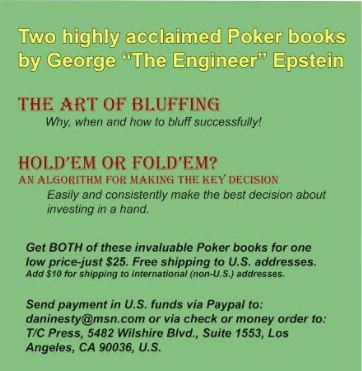
Having to deal with aggressive players at the tables isn’t anyone’s dream scenario. Aggressive players are tricky because they constantly pile on the pressure and force you to make tough decisions. Even if you enjoy the mind games and action, at some point, dealing with all this aggression can become quite frustrating.
To try and help you with this issue, this article will offer you three tips on how to play poker against aggressive players. While their game-plan is usually better and more effective than the one employed by passive calling stations, for example, their aggressive tendencies can be used against them if you make proper strategy adjustments.
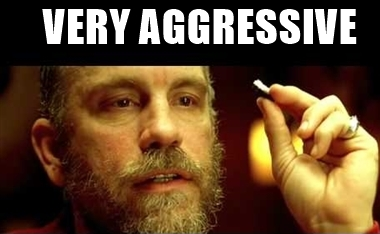
One thing that aggressive players are really good at is attacking weakness. This, at times, can make them look really scary, especially when dealing with experienced LAGs who know what they’re doing.
However, these players are often not used to dealing with aggression themselves and if you occasionally make a stand, you’ll be surprised how often you’ll win.
Whether you play poker online or in a live setting, once you identify someone as a really aggressive player, you need to open your pre-flop game against them. By that, I do not mean that you should be opening more hands pre-flop (which is not good because you will be facing many 3-bets), but don’t be afraid to 3-bet their frequent raises and 4-bet their 3-bets.
Mix things up with some value hands and some bluffs containing blockers to keep the balance but don’t let them keep doing their thing without consequences.
If their hand ranges are too wide, you can exploit this by challenging them, especially when in position. Thus, make sure to follow Texas Holdem poker cheat sheets to get a solid starting point and then adjust these ranges to counter aggressive players.
One of the biggest traps aggressive players fall into is not being able to control their aggression. This leaves them vulnerable to observant players who understand what they’re doing. If you pick up a big hand against an aggressive player, whether before the flop or on the flop, you need to allow them to stay in control and keep pushing the action.
Aggressive players will often fold in face of aggression; however, if you disguise your hand and let them barrel away, they’ll often fire multiple bets in hopes of getting you off what seems like a mediocre hand at best. While this approach has some risks, as they’ll occasionally make their hands and win the pot, it is definitely the best way to extract chips from them.
Although these players will often fire big on multiple streets, you need to be capable of calling them down with what stands to be the best hand a large percentage of the time. Don’t start second-guessing yourself halfway through the hand unless the board run-out is truly horrible and warrants reconsidering.
You want to trap aggressive players with big hands that have a decent showdown value and don’t require too much help on the flop. Trying to flop sets or make straights against these types of players can end up being a very expensive endeavor in the long-term as they’ll keep firing, meaning that you’ll have to concede all the pots where you miss. At the same time, given their wide range, you might not even get their entire stack when you do flop big.
Given this fact, you should be very particular with your hand selection before the flop and avoid playing speculative hands against these players, especially out of position. You will have more than enough opportunities to catch these players with big hands so you don’t necessarily need to get involved with your mediocre holdings and get yourself in difficult spots.
Whether it is a Texas Hold’em tournament at a Las Vegas casino, popular online slots games, or a high-stakes cash game at one of the top poker rooms online, you want to make sure you have the best strategy in place when playing in order to win money. Poker remains one of the most popular forms of real money gambling online, but playing is one thing; winning can be a whole other ball game without the right strategy.
The best poker players in the world each have their own unique playing habits and strategy. Generally speaking, however, you’ll find a few standard types of playing styles out there that we’ll briefly describe below.
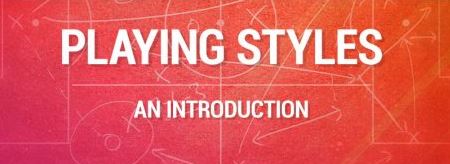
This poker style is also known as TAG. It is considered to be the style of choice for the majority of winning players. The main attributes of this style include extremely selective starting hands. Bluffing is not really part of the strategy since only 18 to 25 percent of the hands are played. The aggressive approach kicks in once post-flop play begins. This approach favors betting and raising as opposed to checking and calling.
The next winning style is referred to as LAG. More losing players are linked to this style. However, the ones that know how to perfect this strategy tend to win more than a typical player using the TAG style. The primary difference is playing far more hands pre-flop. The play rate for the LAG style increases to 23 to 30 percent on dealt hands. This will obviously lead to greater losses over the extended course of play. LAG is also tied to the aggressive approach to playing out the hand post-flop.
This third style reflects tightness. It is very similar to the TAG style, with an even more limited selection of played hands. The nit/rock is willing to wait things out until the cards fall their way in the pre-flop. This style has grown in popularity with the increased competitiveness built into online poker. That said, these types of players lack the overall skill set that many of the top poker players in the game possess. Another characteristic is the fear of losing money. Since their range of play is rather limited, the overall win rate with this style remains low. After all, it’s relatively easy to spot a rock, and thus avoid tangling with such a player if they start making moves.
Poker players adopting this style have been described as hyper-aggressive LAG. With a much higher pre-flop play rate and a highly aggressive trait of betting and raising post-flop, these players have a tendency to both win big and lose big. The true maniac will play more than 30 percent of their dealt hands. This range can even go as high as 50 percent! This is why this style results in far more losses. It is hard to find a maniac who can win at poker over long-term play.
It’s thought that the best style of the four is TAG, as it offers the best balance between overall profitability tied to a higher level of playing skill. The LAG style can actually create a higher win rate, of course, but the risk/reward factor is highly elevated. The maniac style is the most interesting, but to be successful it takes a very high level of poker playing skill. At the end of the day, you need to select the style that best fits your personality, and also be prepared to mix things up a little. Knowing how to identify the styles of other players at the table is a critical skill, too.
It’s way too easy to get lost in the rabbit hole of the poker vlogosphere in 2019.
Andrew Neeme, Brad Owen, Jaman Burton, JohnnieVibes, and other pioneers of poker content creation have YouTube channels that can command hours upon hours of your time, but still leave you wanting more.
We’ve seen several newcomers emerge as high-quality content creators in the realm of poker vlogging over the past year, so let’s take a look at seven new vloggers beginning to make names for themselves who have the potential to become the next big thing in poker content creation.

Can you imagine quitting your day job to travel the world, visit some of the planet’s most exotic locations and play poker? That’s exactly what 29-year-old Oliver Biles is doing, and he’s also giving us an excellent poker and travel vlog while he lives the dream.
Biles was one of the two winners selected in last year’s #vloggerinparadise contest, where Andrew Neeme and Jeff Gross issued a vlogger challenge: make a five-episode poker vlog series with the #vloggerinparadise tag, and the best entry wins a Platinum Pass to the 2019 PokerStars Players Championship.
The entries were so good that Neeme and Gross ended up awarding two of Platinum Passes to a pair of very deserving winners, Biles and Matt Kiefer (who we’ll talk about later in this article).
Biles’ first entry for his YouTube channel was part one of five for the contest, and luckily for us he’s kept the vlog going. In the past seven months we’ve seen Biles travel to Cambodia, Vietnam, Bali, and (of course) the Bahamas for the PSPC.
Check out Biles’ debut video for the #vloggerinparadise contest, and be prepared to binge the whole series after that!
The other #vloggerinparadise Platinum Pass went to Matt Kiefer, a 36-year-old family man from Indianapolis who, like Biles, started making vlog episodes for the contest and has keep it up well past the five-episode mark.
Matt tells us a little bit about his poker journey in this entry, with a cameo from Neeme from the PSPC. He then heads to Cincinnati for the $250k guaranteed Jack Poker Open and makes a stop for an order of the city’s famous Skyline Chili along the way.
It’s pretty tough not to root for Kiefer as he tries to make time for poker while balancing family life and a full-time job. Hopefully Matt will keep the vlogs coming!
Marle Cordeiro’s poker vlog quickly became the talk of the poker industry shortly after its debut last fall, and her satirical and sometimes twisted style stirs up plenty of controversy.
Cordeiro’s vlog takes us along on her journey up the poker cash game ladder, mixing in dark humor and commentary about women in poker, as well as hand analysis along the way. Marle’s YouTube channel is one of the fastest-growing poker channels, as she already has more than 23,000 subscribers in just six months.
Vlog entries like “Looking for a Poker Pro Boyfriend” and “Rebuilding My Poker Bankroll” have been the topics of spirited discussion on poker social media.
New Jersey poker pro Trevor Savage is a 15-year veteran of the game, and made his first foray into vlog production in an effort to snag a Platinum Pass in the #vloggerinparadise contest. The resulting product is the “Raising the Nuts” vlog, which recently went over the 3.5k subscriber mark and truly deserves to bring in thousands more!
Highlights from Raising the Nuts include cameo appearances from Trevor’s three children (Ava, Cameron and Andrew), who give us priceless impersonations of some of poker biggest personalities. The above entry sees the Savage children playing Kelly Minkin, Jamie Kerstetter and Bryan Piccioli, along with Andrew playing himself in an effort to get Marle Cordeiro’s attention.
Raising the Nuts is just too good to only mention one entry in this article, so here is some bonus coverage from the vlog. Check out these two entries for appearances by “Andrew Polk”, who gives us some Doug Polk-like hand analysis, as well as the Savage family traveling to the Bahamas for the PSPC with cameos from Joey Ingram, Andrew Neeme, Cordeiro and Oliver Biles.
Trevor Savage’s efforts with this vlog have been widely praised in the poker community, and let’s hope Raising the Nuts blows up in 2019!
Just taking in the first minute of Poker Vlog #9 from MTL MAK lets us know that he’s taking this poker/vlogging/life thing seriously!
This Montreal-based poker player takes through a day in his life in this entry, and he has all of his goals for social media, poker, vlogging, exercise and meditation for the day planned out. The final goal on the list is “Date Night” with his girlfriend, and let’s hope that went well!
MTL MAK’s vlog shows us just how much work and dedication it takes to produce great content and play poker on a daily basis. He’s already up over the 1k subscriber mark after starting the vlog in December 2018, and if he keeps putting out this level of content we can expect that number to exponentially rise.
Nathan Manuel is yet another vlogger that took a shot at the #vloggerinparadise contest, and although he didn’t win a Platinum Pass in the contest, he did finish in the top 5.
Manuel’s YouTube channel documents some of the different ways he tried to win a Platinum Pass. These efforts included trying to learn Japanese to compete in Jamie Staples’ #myultimatesweat contest, and at one point on Manuel’s YouTube channel we get to see Manuel competing in the #vloggerinparadise and #myultimatesweat challenges at the same time.
Neither of those challenges resulted in paydirt, but Manuel found another way to secure a buy-in to the $25k tournament in the Bahamas, winning his trip to the PSPC by taking down the Moneymaker PSPC Tour event at Run It Up Reno VII.
It’s great to watch Manuel finally get the Platinum Pass, and the final entry in the vlog is the PSPC Trip Report, which we take a look at above. The PSPC has come and gone, but let’s hope Manuel continues to give us content throughout 2019.
We have one more #vloggerinparadise participant on this list, as Houston-based player Greg Feeney has continued to produce content well after the conclusion of the contest, with a YouTube channel that’s gaining momentum.
Feeney’s entertaining style really draws in the viewer, as he gives a look at his ventures on the Houston cash-game scene. We find out that Pot-Limit Omaha is extremely popular in Houston, and in the above entry we get some excellent, Andrew Neeme-style analysis of a big PLO session played by Feeney.
The latest entries in Feeney’s vlog are starting to draw thousands of views, and it looks like there’s a bright future in poker content creation for Feeney.
This month I had the chance to meet and interview Zach Gensler, who Is attempting to break the world record for the longest poker session ever played. It doesn’t hurt that he’s a nice guy from my old home state of Minnesota, and a big fan of iNinja Poker, but even if those things weren’t true, his story is interesting.
Just did an interview with @TimeTra38856673 about his world record attempt for longest poker session. Stop by Aria and say hi to him if you’re in the area. He’s going to be there awhile… pic.twitter.com/n1A9tR60nU
— Chris Wallace (@foxpokerfox) April 10, 2019
Zach was in Vegas this month to play an 80-hour session to get ready for his record breaking attempt in late June. Yes, you read that right, 80 hours was just a warm-up! The record currently stands at 115 hours, a mark set by Phil Laak in June of 2010 at the Bellagio here in Vegas. Zach seems confident that he will break that record this summer, and after speaking with him during his training session, I think he’s a favorite to set the record. Before we cover what Zach is doing, let’s look at the mechanics involved of setting a Guinness World Record.
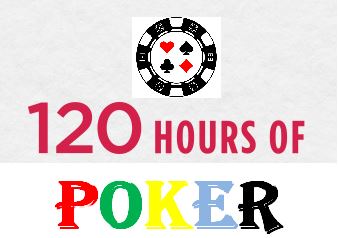
The first thing you have to do is pay around $12,000 for a judge to come over from Europe and adjudicate the record. If everything you did was within the rules and you break the record, the judge will declare you the record holder right then and there. It seems like a big number, but what is immortality worth? Can you say that you hold an official world record? I’ve found a lot of people online claiming longer sessions, but no one knows if they are true. We know Laak’s record is legitimate because a Guinness judge was there and it’s listed on their website.
Then, you must play poker continuously for more than 115 hours. I personally couldn’t come anywhere close to this mark. When I was younger there were definitely some 30-hour sessions, but these days I’m just not sharp after more than 12 hours and being awake for that long sounds awful. Zach will be allowed a five-minute break every hour, and he can save up a few of those breaks if he doesn’t always use them. This might allow him a 15-minute nap at some point, which could be enough REM sleep to really help him plow through to the end.
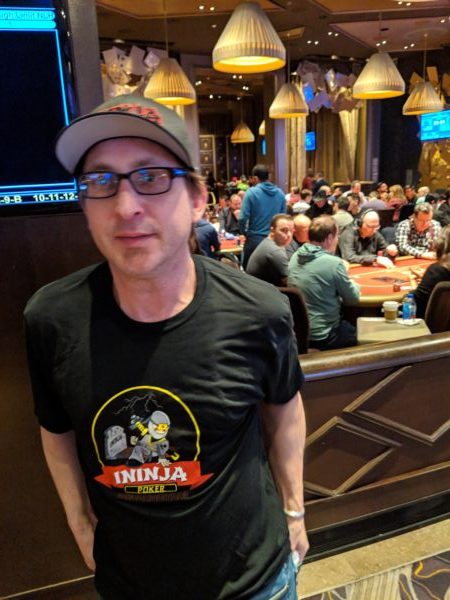
Zach Gensler at the Aria poker room in Las Vegas
For the record to be recognized, you also must play with new players every four hours. It can not be the same opponents for longer than that. I’m not sure why that rule is in place, but that’s what Guinness says, so that’s what he must do. Laak had a bunch of friends show up and swap in and out throughout the game, but Zach wants to do it against random opponents who may not even know about the record attempt. I stopped by his table at hour 33 at the Aria last week during his training session and no one at the table seemed to know that he had even been playing that long.
Zach’s hope is that he can find a poker room that wants to help him with his record attempt, but while Aria has expressed interest, they say they are too busy during the WSOP when Zach is hoping to break the record. If you know a poker room that wants to be part of this record attempt, have them contact me and I’ll put them in touch with Zach. Somewhere in Vegas would be preferred.
I did some research on sleep deprivation and performance before I went to meet with Zach and learned some interesting things. Zach has done this kind of thing before, including some very long poker sessions and other long periods without sleep, so he will probably feel these effects less than you or I might. There is probably some natural ability as well, which Zach believes he has. This certainly jives with research that shows that some people need drastically less sleep than others.
What I learned was that after 72 hours most people simply can not stay awake. They start to have 30-second micro-bursts of sleep, become very irritable, make lots of mistakes, and often start to hallucinate. The desire for sleep becomes very powerful at the three-day mark. But at 80 hours, Zach says he was in pretty good shape. At 33 hours when I interviewed him, he seemed no different than I would be after a six-hour session.
It looks like @TimeTra38856673 is going to make it his first goal of 80 hours in his training to break the world record for longest cash game session later this year. Here’s a short interview I did with him at the 33 hour mark. pic.twitter.com/W6s6HjN8I2
— Chris Wallace (@foxpokerfox) April 11, 2019
I think this feat is similarly equivalent to free divers who can hold their breath for long periods of time. If I don’t breathe for 10 minutes, I will almost certainly die. But free divers have successfully held their breath with no apparent long-term damage for more than 22(!) minutes. Training and natural ability have a big effect on what the body can handle. While Zach has not done any kind of formal training for this attempt, he has certainly had a lot of practice and seems to have some natural ability.
My best guess — and I’m not a scientist or a doctor — is that Zach will complete the 120-hour session and achieve the new world record. It seems very important to him to be a part of poker history, and he really loves the game. I think that by the 100-hour mark he will be seriously impaired, probably not playing very well, possibly having trouble reading his opponents’ facial expressions, and that his mistake rate will soar. But if he plays tight and solid, which seems to be his personality, I think he will be fine. His 80-hour practice session ended in a profit of over $1,500, so he could technically fold his way through the next 40 hours and still be up if he can match that performance when he goes for the record in June.
Timetraveler completed a unofficial 80hr session at ARIA casino Las Vegas in his quest for Guinness World Record for Longest Marathon Poker play.i completed to session $1500 up.I feel like I just ran 100 miles.💪💪💪
— TimeTravelerPoker (@TimeTraveler524) April 14, 2019
Laak reported rambling, being a bit lost, and some minor visual hallucinations. Another record breaker (though his attempt doesn’t seem to have been verified by Guinness), Barry Denson, reported aural hallucinations, believing that there were children playing loudly near the slot machines close to the table when there were no children nearby. Denson’s record attempt made it to 120 hours, though I couldn’t find official verification of this anywhere.
In my search for the official records, I did find some odd, poker-related, records. My favorite was the world record for the largest strip poker tournament, which had 196 participants and was held by Paddy Power in 2006. Well, it was my favorite until I did some, ahem, “research” and found some video of the event. Most of the participants were men, and the final video after the winner was crowned might reveal a bit more of the winner John Young, than you are prepared to see. Unless 115 hours of poker causes him to lose his mind, I assume Zach will keep his clothes on after he breaks the record.
My biggest concern for Zach will be his recovery after the attempt. Research shows that your immune system is in real trouble after a few days without sleep, and a poker room is a great place to be exposed to every possible airborne illness. He will need a lot of sleep after the record, and I’m hoping that he doesn’t wake up fighting off two different colds and a case of the summer flu.
I slept 14hrs after my Marathon Poker https://t.co/ZmB5DDpp8J I’m eat buffet at ARIA hydrating and enjoying Life!I feel good and will be owning the World Record for Longest Marathon Poker play.I love poker for charity!
— TimeTravelerPoker (@TimeTraveler524) April 12, 2019
Even if he does get sick, Zach will probably say that it was worth it. He doesn’t have a bracelet or a WPT title, or even any TV time. He doesn’t have big results on Hendon Mob, or his face on the cover of a magazine either. But if he is successful, he will be a part of poker history.
The cabbie looked out the passenger side window then looked back at me in his rear-view mirror.
“Do it.” I said. And onto the sidewalk he went.
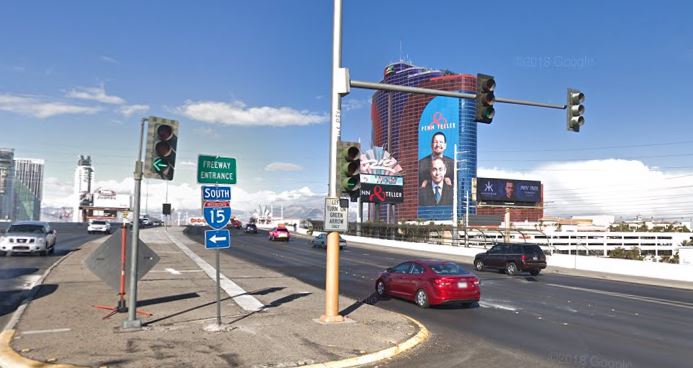
So, how was your first experience playing the WSOP?
I’d always known there’d be some stress and fear associated with it, but the scariest things I could imagine would be facing a big raise for my tournament life, or maybe being 3-bet repeatedly by a pro while I was out of position. Something related to the actual game, not voluntarily putting my life into the hands of a Las Vegas cab driver, giving him the OK to… well, we’ll get there.
In 2009, for the 40th anniversary of the WSOP, they dropped the buy-in of their smallest tournament to $1,000 for the first time. Before the Colossus, the Giant and the Big 50, this was their first attempt at a more recreational friendly price point, and it worked. A massive field was promised, and this recreational player was off to Vegas to be a part of it.
In previous trips to Vegas I’d wandered the halls of the Rio, rubbing shoulders and shaking hands with some of the stars of the poker world. But the closest I’d come to playing an event was a failed attempt at a $150 satellite in 2004, back in the last days of Binion’s as its home.
In 2009 though, the combo of a $1k price point and the 40th anniversary — well that was a clincher. I was a home game hero, an online punter, and a marginal $1-2 NLHE winner, but I’d never really had the bankroll to justify firing a WSOP event, so finally I was going to take a shot… and I couldn’t wait!
READ: How to Compete at the WSOP with a Four-Figure Bankroll
I landed at McCarran International with an anticipation like I’d never had before. Sure, I’d played poker every time I’d been to Vegas previously, but this was different. The mystique and energy of playing your first WSOP event is real, and that begins well before you even set foot in the Rio.
I checked into the Hooters Hotel and Casino (yup, really… and it’s as orange and cheesy as you’d imagine, but hey, it was cheap) the afternoon before the tournament and settled in to have the least Vegas-y first night ever. I studied, watched a movie, ordered a nice salmon and vegetable dinner from room service… OF COURSE NOT! I had friggin’ wings! Then I went to bed early. There was work to be done the next day.
Despite the anticipation raging through my body I actually managed to have a decent sleep and woke up feeling great. Time to start the day with a run on the Strip, grab a smoothie, and then get ready for the big day.
I put on my gym gear, tucked my ID and a few bucks into the Velcro pocket, and embarked onto Tropicana avenue to begin my run. (By the way, if you’ve never experienced a break of day run on the Vegas Strip, I highly recommend it. The combination of comfortable running weather and post-club people watching is phenomenal!)
Following a run to the Wynn and back, I returned feeling energized, strong, and ready to battle. I showered, dressed, loaded up my backpack and headed back downstairs to hail a taxi.
The butterflies kicked in as soon as I saw the Rio in the distance. Here we go!

The Rio (left) looming in the distance
The cab pulled up to the back entrance of the Rio convention center with about 20 minutes until cards were in the air. I’d allotted plenty of time to have a few moments to enjoy the anticipation, then try to fight off some of those butterflies before I sat down at my table. As soon as I walked into the building and smelled those Rio hallways, there were even more to fight. Among the buzz of thousands of poker players I found a semi quiet corner, chilled for a few minutes, and then headed toward the Brasilia room.
As I entered the room and was serenaded by ‘Ecstasy of Gold’ for the first time, the butterflies erupted again, and a massive wave of nervous, giddy energy just plowed me. It was awesome.
I sat down, opened my backpack, took the entry slip from my wallet and presented it to the dealer. He pushed my 3,000 in tournament chips forward.
“Can I also see your ID, sir?”
Oh of course, they need my ID, duh. I reached back into my backpack to grab my wallet again and give him my driver’s licence.
It. Wasn’t. Fucking. There.
The butterflies dropped to the pit of my stomach like a blast of pesticide had just been pumped into my gut. They were dead, and I felt sick.
The dealer called a floorman over, and he provided the gory details. My chips would be in play, but I couldn’t play them until I could present ID.
As this was being explained to me, the dulcet tones of Jack Effel came over the loudspeaker announcing that the blinds were 25/25 with 30-minute levels. Shuffle up and deal!
And blind off if you’re a dummy who forgot his ID.
Ecstasy of Gold was replaced in my head by the William Tell Overture as I raced out of the room toward the back entrance and the taxi stand. (Fun fact: at this moment, no one in history ever has, or ever will have, as desperate a desire to get to a Hooters as I did.)
I jumped into the back seat of the first taxi I saw, closed the door and frantically told the driver about my dwindling chip stack and that I needed to get to my beautiful orange hotel as fast as possible.
He looked back at me and with a mischievous, zealous smile proclaimed, “well alright then!”
*Disclaimer: The following actions of both myself and the cab driver I do not necessarily condone. However, at the time, knowing that in 30 minutes I’d be down to a sub 60 BB stack and in an hour under 30, hey man, desperate times!
The cab bolted from the curb onto the windy two-lane exit road from the back of the Rio, but before we could even get close to the Flamingo road exit, a lengthy line of cars in front of us halted our progress.
One lane in, one lane out and not much else. The Lone Ranger music screeched to a halt, until…
The cabbie looked out the passenger side window then looked back at me in his rearview mirror.
“Do it.” I said. And onto the sidewalk he went.
Weaving between the stopped cars on his left and the pedestrians jumping out of the way, we squeezed our way toward the main entrance where fortune smiled on us and we actually caught a green light, and from the right turn lane cut everyone off and hung a left toward the freeway!
Across Flamingo and onto the I-15 we raced. The driver hammering the accelerator as we flew toward the Tropicana exit, topping 100 mph before we slowed to pull off. More Fast and Furious-style rungood as we caught the light and turned onto Tropicana, tires squealing. Toward the Strip we went, but a cluster of cars across the five eastbound lanes between New York-New York and Excalibur awaited us.
“Watch this”, my new best friend exclaimed.
He swerved into an open far right lane which turned south onto the Strip toward Mandalay Bay. I thought he was either turning toward some back entrance I didn’t know about or was going to just fly right through a red light into 10+ lanes of Las Vegas Blvd. traffic. Oh, dear god.
But no. By some other-worldly Las Vegas cab driver voodoo, without stopping, he knew the light was changing. Red became green and he then swerved back in front of the eastbound traffic as we continued across Tropicana. Frank Bullitt had nothing on this guy!
Back at the hotel in record time, I speed walked through the casino (despite my hurry, I’ve heard running through a casino is frowned upon), sprinted down the hallway to my room, practically kicked the door open and ripped my driver’s licence from my gym shorts. Then it was back downstairs, jump back into the cab and round two of our journey.
If I’d run as well in the tournament as I did in this Hollywood blockbuster of a cab ride, I’d be rocking a bracelet right now. Following a string of glorious green lights, another drag race up the freeway and another tire squealing screech upon arrival back at the Rio, we’d somehow completed this journey in under 20 minutes!
I paid the driver, tipped him an extra $20, ran back into the Rio, burst open the doors to the Brasilia room and returned triumphantly to my seat. I exhaled and showed the dealer my ID as he greeted me with a snicker and a friendly “welcome back, sir”.
As I tried to catch my breath while the rest of the table looked at me with varying levels of hilarity, I cut out my chips and counted. My original 3,000 was now… 2,950.
Hmm, maybe all that wasn’t really necessary.
As for the tournament (oh yeah, that), the excitement of my first WSOP event was a little different than that of my life flashing before my eyes as I flew through the streets of Las Vegas, but once my heart rate returned to normal poker playing levels, it was damn cool.
I got to play with several recognizable players, including Brandon Adams at that opening table, Vanessa Rousso, Barry Shulman, and eventual winner Steve Sung.
I survived Day 1 with a decent stack of 25,000 after tripling up with pocket aces on the final hand of the day, earning myself a bag and a real chance to make the money the next day.
Between the thrill of making Day 2 and thoughts of my little car ride, I didn’t sleep nearly as well that night. But before my futile attempt at it, I made damn sure all my necessary paperwork and ID for Day 2 was in that backpack.
I returned to the Rio the following day weary from lack of sleep, with adrenaline carrying me through the early levels where I probably played way too tight. But I wanted a profile on WSOP.com and my first result on the Hendon Mob. If I could run it up after that, cool. For my bankroll, a min cash was way better than no cash.
After about four hours of play with my stack dwindling to under 10 BB, the bubble burst and the final 620 players from a starting field of 6,012 entrants were in the money. Mission accomplished!
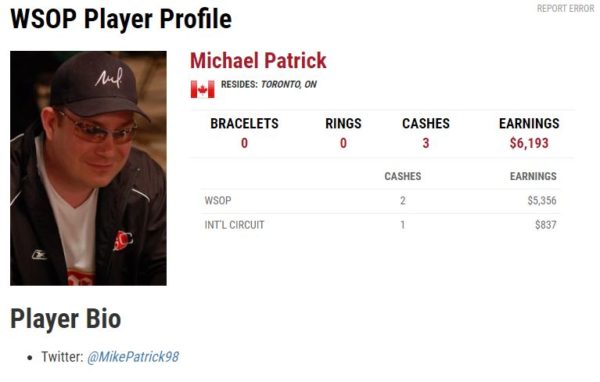
The look of a man who just an hour before this photo was taken was encouraging potential vehicular homicide. | Image credit: WSOP.com
From there I managed to double up and ladder past a min cash, but soon after I got AJ in pre-flop against KQ for my last 15 BB and couldn’t hold. I finished in 507th place for a little over $2,000, along with a new appreciation for Las Vegas cab drivers, and a helluva story. I wished my table mates good luck then headed back into the Rio hallways and to the cash cage to collect my winnings.
After tucking the money into my backpack I walked out to the taxi stand, where a cab was waiting. I hopped into the backseat and was greeted with a smile from an older lady behind the wheel.
“Hi there sir, where to?”
“Just back to my hotel. I’m at Hooters. Take your time.”
Editor’s note: This is Lesson #11 in our weekly “Strategy with Stas” series. Each and every Sunday Stas Tishkevich, founder of the Poker Fighter Training App, brings you a new lesson in article + video format. We hope you enjoy this feature from the Poker Fighter School, and would be happy for you to share these posts — as well as your feedback — on social media.
Action is folded to player in the small-blind, who open-raises the pot. Most players will open-raise a wide range from this position — at least 35% of possible starting hands — and our pocket kings are way ahead of this opening range, so we should almost always re-raise our hand in this spot. This re-raise is called a 3-bet, as it is a raise over the opponent’s open-raise (2-bet).
Just calling pocket kings from the big-blind vs. a small-blind’s open-raise will usually not maximize our hand’s potential.
So we re-raise from the big-blind and the small-blind re-raises again, meaning he makes a 4-bet, a raise over our 3-bet.
Different players will have different 4-bet ranges in this spot, so it’s important to understand the type of opponent you are facing in this particular situation.
The most passive players will have a nutted 4-bet range – hands like pocket kings and aces, maybe pocket queens and ace-king.
The standard player can add in this specific spot, small-blind vs. big-blind, hands like pocket tens and jacks, ace-queen, maybe even ace-jack.
Loose-aggressive players can either go wider for value (pocket nines or king-queen for example), or add semi-bluffs (low suited aces or suited connectors for example).
We need to decide what to do with our pocket kings, and folding is obviously not an option.
There are two possible lines in this spot:
A GTO approach claims 100 big blinds deep, we shouldn’t have a re-raise (5-bet) range. This means that all the hands we will decide to play will just call vs. the opponent’s 4-bet, be it ace-queen or pocket aces. In this way our range will be balanced and the opponent will not know if we have a nutted hand or just a strong hand.
This approach should be used when playing vs. thinking players who are capable of folding good hands vs. a 5-bet.
An exploitative approach claims that you should always take the most +EV line with your hand vs. the specific opponent you are playing against.
Versus weak non-folding opponents, you should re-raise (5-bet) with the hands you think are ahead of his 4-bet range (pocket aces and kings for example), call the hands that are more or less equal to his 4-bet range (pocket queens and ace-king for example), and fold the hands that are behind your opponent’s 4-bet range (ace-queen or ace-jack for example).
Versus loose aggressive players who 4-bet too much and are capable of folding, we can 5-bet with our bluff-hands (ace-ten or king-queen for example), and just call our nutted hands (pocket aces and kings for example) inducing bluffs post-flop.
Normally when playing for low stakes, most of the opponents we will be facing tend to play too loose pre-flop (calling too much), but when they raise or re-raise, they usually have a strong hand. They also tend to call too much, especially when they think they have a good hand.
Versus these players, loose-passive and non-folding, we should probably use an exploitative approach and re-raise our nutted hands to extract maximum value pre-flop before action-killers come on the flop.
We can use various 5-bet sizings depending on what we want to accomplish, but the standard 5-bet sizing when playing 100 big blinds deep will usually be shoving all-in and praying that our opponent will not snap-call with pocket aces…
The main point we need to understand here pre-flop is that there isn’t only one possible move, but rather many different lines we can use based on the player type we face, and his perceived range.